Felidae
| Felidae[1] Temporal range: Oligocene–Present, 25–0 Ma PreЄ Є O S D C P T J K Pg N | |
|---|---|
 | |
| Clockwise from top left: tiger (Panthera tigris), Canadian lynx (Lynx canadensis), fishing cat (Prionailurus viverrinus), wildcat (Felis silvestris), ocelot (Leopardus pardalis), Asian golden cat (Catopuma temminckii), serval (Leptailurus serval) and cougar (Puma concolor). | |
Scientific classification | |
| Kingdom: | Animalia |
| Phylum: | Chordata |
| Class: | Mammalia |
| Order: | Carnivora |
| Suborder: | Feliformia |
| Family: | Felidae Fischer von Waldheim, 1817 |
Type genus | |
Felis Linnaeus, 1758 | |
| Subfamilies | |
Pantherinae | |
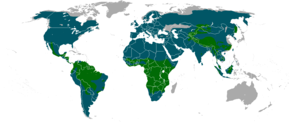 | |
| Felidae ranges | |
Felidae is a family of mammals in the order Carnivora, colloquially referred to as cats. A member of this family is also called a felid or feline.[3][4][5][6] The term "cat" refers both to felids in general and specifically to domestic cats.
The characteristic features of cats have evolved to support a carnivorous lifestyle, with adaptations for ambush or stalking and short pursuit hunting. They have slender muscular bodies, strong flexible forelimbs and retractable claws for holding prey, dental and cranial adaptations for a strong bite, and often have characteristic striped or spotted coat patterns for camouflage.
The Felidae comprises two subfamilies, the Pantherinae and the Felinae. The former includes the Panthera species tiger, lion, jaguar, leopard, snow leopard, and Neofelis species clouded leopard and Sunda clouded leopard.[5] All the non-pantherine cats are part of the Felinae, which includes several genera and the majority of cat species.[7]
The first cats emerged during the Oligocene, about 25 million years ago, with the appearance of Proailurus and Pseudaelurus. The latter species complex was ancestral to two main lines of felids, the cats in the extant subfamilies and a third major group of extinct cats, which are assigned to the subfamily Machairodontinae. The machairodonts included the saber-toothed cats such as the Smilodon. The "false sabre toothed cats", the Barbourofelidae and Nimravidae, are not true cats, but are closely related and together with Felidae and other cat-like carnivores (hyaenas, viverrids and mongooses) make up the feliform carnivores.
Contents
1 Characteristics
1.1 Senses
1.2 Vocalisations
2 Classification
2.1 Extant species
2.2 Fossil genera
2.3 Fossil felids
3 Evolution
3.1 Phylogeny
4 Habitat and ecology
5 See also
6 Cited references
7 General references
8 External links
Characteristics

Skull of a lion from Kruger National Park
All members of the cat family have the following characteristics in common:
- They have lithe and flexible bodies with muscular limbs.[8]
- They are digitigrade, have five toes on their forefeet and four on their hind feet.[9]
- The plantar pads of both fore and hind feet form compact three-lobed cushions.[10]
- They have protractile curved claws that are attached to the terminal bones of the toe with ligaments and tendons.[9] The claws are actively protracted by contracting muscles in the toe,[8] and they are passively retracted. The dewclaws are expanded but do not protract.[11] The claws are guarded by cutaneous sheaths, except in the cheetah.[9]
- Their skull is foreshortened with a rounded profile and large orbits.[11]
- Their nose projects slightly beyond the lower jaw.[9]
- They have a muzzle with 30 teeth and a dental formula 3.1.3.13.1.2.1. The canine teeth are large, reaching exceptional size in the extinct saber-toothed species. The upper third premolar and lower molar are adapted as carnassial teeth, suited to tearing and cutting flesh.[8] The lower carnassial is smaller than the upper carnassial and has a crown with two compressed blade-like pointed cusps.[10]
- Their tongue is covered with horny papillae, which rasp meat from prey and aid in grooming.[11]
- They have well developed and highly sensitive whiskers above the eyes, on the cheeks, on the muzzle, but not below the chin.[9] Whiskers help to navigate in the dark and to capture and hold prey.[11]
- Their eyes are relatively large, situated to provide binocular vision. Their night vision is especially good due to the presence of a tapetum lucidum, which reflects light back inside the eyeball, and gives felid eyes their distinctive shine. As a result, the eyes of felids are about six times more light sensitive than those of humans, and many species are at least partially nocturnal. The retina of felids also contains a relatively high proportion of rod cells, adapted for distinguishing moving objects in conditions of dim light, which are complemented by the presence of cone cells for sensing colour during the day.[8]
- Their external ears are large, and especially sensitive to high-frequency sounds in the smaller cat species. This sensitivity allows them to locate small rodent prey.[8]
- Relative to body size, they have shorter bacula than canids.[12] The penis is subconical and boneless.[9]
The colour, length and density of their fur are highly variable. Fur colour varies from brown to golden, and fur pattern from distinctive small spots, stripes, to small blotches and rosettes. Those living in cold environments have thick fur with long hair, like the snow leopard and the Pallas's cat.[11] Those living in tropical and hot climate zones have short fur. The only cat species lacking significant markings are the lion, cougar, caracal, jungle cat and jaguarundi. Several species exhibit melanism with all-black individuals.[8]
In the great majority of species, the tail is between a third and a half of the body length, although with some exceptions, like the Lynx species and margay.[8]
Cat species vary greatly in body and skull sizes, and weights:
- The largest cat species is the tiger, with a head-to-body length of up to 390 cm (150 in), a weight range of at least 65 to 325 kg (143 to 717 lb), and a skull length ranging from 316 to 413 mm (12.4 to 16.3 in).[8][13] Although the maximum skull length of a lion is slightly greater at 419 mm (16.5 in), it is generally smaller in head-to-body length than the former.[14]
- The smallest cat species are the rusty-spotted cat and the black-footed cat. The former is 35 to 48 cm (14 to 19 in) in length and weighs 0.9 to 1.6 kg (2.0 to 3.5 lb).[8] The latter has a head-to-body length of 36.7 to 43.3 cm (14.4 to 17.0 in) and a maximum recorded weight of 2.45 kg (5.4 lb).[15][16]
Senses
Felids also have a highly developed sense of smell, although not to the degree seen in canids; this is further supplemented by the presence of a vomeronasal organ in the roof of the mouth, allowing the animal to "taste" the air. The use of this organ is associated with the Flehmen response, in which the upper lip is curled upwards. Most felids are unable to taste sweetness due to a mutated gene in their taste buds.
Most felids are able to land on their feet after a fall due to the cat righting reflex.
Vocalisations
All felids share a broadly similar set of vocalisations, but with some variation between species. In particular, the pitch of calls varies, with larger species producing deeper sounds.
All felids are able to spit, hiss, growl, snarl, and mew. The first four sounds are all used in an aggressive context. The spitting sound is a sudden burst, typically used when making threats, especially towards other species. The hiss is a prolonged, atonal sound used in close range to other members of the species, when the animal is uncertain whether to attack or retreat.
The mewing sound may be used either as a close-contact call, typically between a mother and kittens, or as a louder, longer distance call, primarily during the mating season. The acoustic properties of the mew vary somewhat between different felid species; extreme examples include the whistling sound made by cougars and the mew-grunt of lions and tigers.[citation needed]
Domestic cat purring and meowing.
Most felids seem to be able to purr, vibrating the muscles in their larynx to produce a distinctive buzzing sound. In the wild, purring is used while a mother is caring for kittens. Precisely which species of felids are able to purr is a matter of debate, but the sound has been recorded in most of the smaller species, as well as being common for the cheetah and cougar, and may also be found in other big cats.
Other common felid vocalisations include the gurgle, wah-wah, prusten, and roar. The first two sounds are found only among the Felinae (small cats). Gurgling is a quiet sound used during meetings between friendly individuals, as well as during courtship and when nursing kittens. The wah-wah is a short, deep-sounding call used in close contact, and is not found in all species (it is, for example, absent in the domestic cat).
In contrast, only Panthera species can prusten and roar. Prusten is a short, soft, snorting sound reported in tigers, jaguars, snow leopards, and clouded leopards; it is used during contact between friendly individuals. The roar is an especially loud call with a distinctive pattern that depends on the species. The ability to roar comes from an elongated and specially adapted larynx and hyoid apparatus.[17] When air passes through the larynx on the way from the lungs, the cartilage walls of the larynx vibrate, producing sound. Only lions, leopards, tigers, and jaguars are truly able to roar, although the loudest mews of snow leopards have a similar, if less structured, sound.[8]
Classification
Traditionally, five subfamilies have been distinguished within the Felidae based on phenotypical features: the Felinae, the Pantherinae, the Acinonychinae (cheetahs), the extinct Machairodontinae, and the extinct Proailurinae.[2]
Molecular phylogenetic analysis suggests that living (extant) felids fall into eight lineages (clades).[1][18][19][20] The placement of the cheetah within the Puma lineage invalidates the traditional subfamily Acinonychinae, and recent sources use only two subfamilies for extant genera.[1] The eight lineages divide between these as follows:
- Subfamily Pantherinae:
- Lineage 1 (Panthera lineage): Panthera, Neofelis
- Lineage 1 (Panthera lineage): Panthera, Neofelis
- Subfamily Felinae:
- Lineage 2 (Bay cat lineage): Pardofelis, Catopuma
- Lineage 3 (Caracal lineage): Leptailurus, Caracal
- Lineage 4 (Ocelot cat lineage): Leopardus
- Tribe Felini:
- Lineage 5 (Lynx lineage): Lynx
- Lineage 6 (Puma lineage): Puma, Acinonyx, Herpailurus
- Lineage 7 (Leopard cat lineage): Prionailurus, Otocolobus
- Lineage 8 (Domestic cat lineage): Felis
- Lineage 5 (Lynx lineage): Lynx
- Lineage 2 (Bay cat lineage): Pardofelis, Catopuma
The last four lineages are more related to each other than to any of the first four, so form a clade within the subfamily Felinae of family Felidae.[18]
Extant species
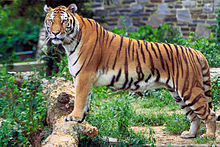
Tiger

Lion

Jaguar

Leopard

Eurasian lynx

Cougar
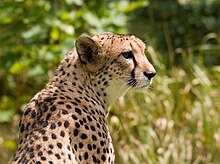
Cheetah
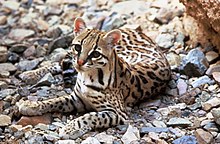
Ocelot

Margay

Leopard cat

European wildcat
The following is the complete list of genera within the Felidae, grouped according to the traditional phenotypical classification with the corresponding genotypical lineages indicated. It includes all of the currently living cat species.[1][21]
- Subfamily Pantherinae
- Genus Panthera [Lineage 1]
Tiger (Panthera tigris)
Lion (Panthera leo)
Jaguar (Panthera onca)
Leopard (Panthera pardus)
Snow leopard (Panthera uncia; syn., Uncia uncia)[22]
- Genus Neofelis [Lineage 1]
Clouded leopard (Neofelis nebulosa)
Sunda clouded leopard (Neofelis diardi)
- Genus Panthera [Lineage 1]
- Subfamily Felinae
- Genus Pardofelis [Lineage 2]
Marbled cat (Pardofelis marmorata)
- Genus Catopuma [Lineage 2] — syn. Pardofelis[18]
Bay cat (Catopuma badia) — syn. P. badia[18]
Asian golden cat (Catopuma temminckii) — syn. P. temminckii[18]
- Genus Caracal [Lineage 3]
Caracal (Caracal caracal)
African golden cat (Caracal aurata) — syn. Profelis aurata;[18][23]
- Genus Leptailurus [Lineage 3]
Serval (Leptailurus serval[21]:58 or Caracal serval[18])
- Genus Leopardus [Lineage 4]
Pampas cat (Leopardus colocola). Most authorities recognise the Pampas cat as a single species,[18][21]:51 although some authorities recognise three species as follows:[1]
Pantanal cat (Leopardus braccatus or Leopardus colocolo braccatus)
Colocolo (Leopardus colocolo or Leopardus colocolo colocolo)
Pampas cat (Leopardus pajeros or Leopardus colocolo pajeros)
Geoffroy's cat (Leopardus geoffroyi)
Kodkod (Leopardus guigna)
Southern tigrina (Leopardus guttulus)
Andean mountain cat (Leopardus jacobitus)
Ocelot (Leopardus pardalis)
Oncilla (Leopardus tigrinus)
Margay (Leopardus wiedii)
- Tribe Felini
- Genus Lynx [Lineage 5]
Canadian lynx (Lynx canadensis)
Eurasian lynx (Lynx lynx)
Iberian lynx (Lynx pardinus)
Bobcat (Lynx rufus)
- Genus Puma [Lineage 6]
Cougar (Puma concolor)
Jaguarundi (Herpailurus yagouaroundi)
- Genus Acinonyx[1][Lineage 6]
Cheetah (Acinonyx jubatus)
- Genus Prionailurus [Lineage 7]
Fishing cat (Prionailurus viverrinus)
Leopard cat (Prionailurus bengalensis)
Iriomote cat (Prionailurus bengalensis iriomotensis)[21]:27 [sometimes recognised as a distinct species Prionailurus iriomotensis[1]]
Sunda leopard cat (Prionailurus javanensis)[21]:28
Flat-headed cat (Prionailurus planiceps)
Rusty-spotted cat (Prionailurus rubiginosus)
- Genus Otocolobus [Lineage 7]
Pallas's cat (Otocolobus manul)
- Genus Felis [Lineage 8]
Jungle cat (Felis chaus)
Sand cat (Felis margarita)
Black-footed cat (Felis nigripes)
European wildcat (Felis silvestris)[21]
African wildcat (Felis lybica)[21]
Chinese mountain cat (Felis bieti)
Domestic cat (Felis catus)
- Genus Lynx [Lineage 5]
- Genus Pardofelis [Lineage 2]
There is considerable variation in the taxonomy used for the wildcat. It used to be regarded as Felis silvestris with distinct subspecies F. s. silvestris, F. s. lybica and F. s. ornata in Europe, Africa and Asia respectively. Since 2017, the IUCN Cat Specialist Group recognises silvestris and lybica as distinct species.[21]:16
Fossil genera

The American lion was one of the abundant Pleistocene megafauna, a wide variety of very large mammals that became extinct about 10,000 years ago.[24]

Megantereon
The list follows McKenna and Bell's Classification of Mammals for prehistoric genera. The list differs from McKenna and Bell as follows: Sivapanthera is included in the Felinae, as Acinonychinae is no longer recognised as distinct subfamily; Viretailurus is considered a synonym of Puma; Ischyrosmilus is considered a synonym of the genus Homotherium;[25] and several newly recognised genera, including Miracinonyx, Lokotunjailurus and Xenosmilus, have been added.
Proailurinae
- Proailurus
- Pseudaelurus
Felinae
- Sivaelurus
Pikermia[citation needed]
Abelia[citation needed]
- Pratifelis
Dolichofelis[citation needed]
Sivapardus[citation needed]
- Sivapanthera
- Miracinonyx
Katifelis[26]
Asilifelis[27]
Namafelis[27]
Diamantofelis[27]
Pantherinae
Leontoceryx[citation needed]
Dromopanthera[citation needed]
Schaubia[citation needed]
Machairodontinae
- Tchadailurus
- Tribe Metailurini:
Metailurus (Miocene, Pliocene, Middle Pleistocene; North America, Eurasia, Africa)[28]
Adelphailurus (Miocene; North America)- Stenailurus
Dinofelis (Early Pliocene,Early Pleistocene; Eurasia, Africa, North America)(Late Miocene, Africa, Eurasia, North America)[28]
Yoshi (Miocene; Europe)[29]
- Tribe Smilodontini:
Smilodon (Pleistocene; North South America)
Rhizosmilodon (Pliocene, North America)
Megantereon (Pliocene, Pleistocene; North America, Africa, Eurasia)
Promegantereon (Miocene, Spain)[28]
Paramachairodus (Late Miocene; Eurasia, Africa)
- Tribe Homotherini:
Homotherium (Pliocene, Pleistocene; Africa, Eurasia, North America)
Lokotunjailurus (Latest Miocene; Africa)
Nimravides (Middle to Late Miocene; North America)[28]
Xenosmilus (Pleistocene; North America)
Amphimachairodus (Late Miocene; Africa, Eurasia, North America)[28]
- Tribe Machairodontini:
Machairodus (Late Miocene; Africa, Eurasia, North America)[28]
Miomachairodus (Middle Miocene; Africa, Asia)- Hemimachairodus
Fossil felids
Possibly the oldest known true felid (Proailurus) lived in the late Oligocene and early Miocene epochs. During the Miocene, it gave way to Pseudaelurus. Pseudaelurus is believed to be the latest common ancestor of the two extant subfamilies and the extinct subfamily, Machairodontinae. This group, better known as the saber-tooth cats, became extinct in the Late Pleistocene era. The group includes the genera Smilodon, Machairodus and Homotherium. The Metailurini were originally classified as a distinct tribe within Machairodontinae, though they count as members of the Felinae in recent times.[30][31] Most extinct cat-like animals, once regarded as members of the Felidae, later turned out to be members of related, but distinct, families: the "false sabretooths" Nimravidae and Barbourofelidae. As a result, sabretooth "cats" seem to belong to four different lineages. The total number of fossil felids known to science is low compared to other carnivoran families, such as dogs and bears. Felidae radiated quite recently and most of the extant species are relatively young.
Evolution
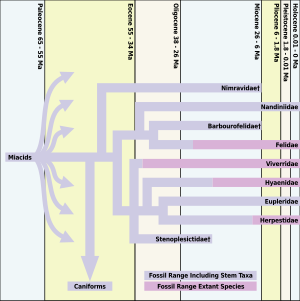
Feliform evolutionary timeline
Results of mitochondrial analysis indicates that all the Felidae descended from a common ancestor. Cats originated in Asia and spread across continents by crossing land bridges. Testing of mitochondrial and nuclear DNA revealed that the ancient cats evolved into eight main lineages that diverged in the course of at least 10 migrations (in both directions) from continent to continent via the Bering land bridge and the Isthmus of Panama, with the genus Panthera being the oldest and the genus Felis being the youngest. About 60% of the modern cat species are estimated to have developed within the last million years.[18]
The Felidae's closest relatives are thought to be the Asiatic linsangs.[32] Together with the viverrids, hyenas, mongooses, and Malagasy carnivores, they form the suborder Feliformia.[33]
Most cat species share a genetic anomaly that prevents them from tasting sweetness.[34] This is believed to be because their diet consists so strictly of meat (which contains no concentrated sugar) and therefore the taste of sugar signals nothing important for the felid brain and confers no evolutionary advantages. While some individual felids may be able to taste sugar, this ability is not characteristic of any felid species as a whole.
Most cat species have a haploid number of 18 or 19. New World cats (those in Central and South America) have a haploid number of 18, possibly due to the combination of two smaller chromosomes into a larger one.[35]
Domestic cats may either have a long or short tail. At one point, biologists had to consider whether the short tail also found in the lynx was the ancestral or derived trait. Without looking at the fossil record, researchers were able to look at the character states found in their outgroups. Because all animals belonging to Felidae's sister taxa, Viverridae, have long tails, scientists could infer that this character state represents the ancestral trait.[33]
Some domestic cats display a rosette pattern on their coats. This character state, however, is not related to the rosettes found on big cats. Domestic cats and big cats underwent convergent evolution for this trait. The most common ancestor to all cats had a flecked coat. Lynxes display this character state. The jaguarundi lost this character state secondarily. The most common recent ancestor of snow leopards, tigers, jaguars, lions, and leopards developed a coat with rosette patterns from the flecked patterns. Tigers and lions, however, do not display rosettes as adults. They both have lost this ancestral character state over time. Adult tigers actually display elongated rosettes that now appear as stripes. Adult lions seem to lack any distinctive markings altogether. Both juvenile tigers and lions, however, display partial rosettes. This ancestral character state appears only during these early stages, supporting the notion that ontogeny reflects phylogeny. The rosette patterns found on snow leopards, jaguars, and leopards all have a common origin.[36]
Fossil occurrences indicate that the Felidae arrived in North America about 10 million years later than the Canidae, and about 20 million years later than the Ursidae and the Nimravidae.[37]
Phylogeny
The phylogenetic relationships of extant felids are shown in the following cladogram, based on the molecular phylogenetic analysis of Johnson et al. (2006).[18] The lineages, genera and species are as used in that study.
.mw-parser-output table.clade{border-spacing:0;margin:0;font-size:100%;line-height:100%;border-collapse:separate;width:auto}.mw-parser-output table.clade table.clade{width:100%}.mw-parser-output table.clade td{border:0;padding:0;vertical-align:middle;text-align:center}.mw-parser-output table.clade td.clade-label{width:0.8em;border:0;padding:0 0.2em;vertical-align:bottom;text-align:center}.mw-parser-output table.clade td.clade-slabel{border:0;padding:0 0.2em;vertical-align:top;text-align:center}.mw-parser-output table.clade td.clade-bar{vertical-align:middle;text-align:left;padding:0 0.5em}.mw-parser-output table.clade td.clade-leaf{border:0;padding:0;text-align:left;vertical-align:middle}.mw-parser-output table.clade td.clade-leafR{border:0;padding:0;text-align:right}
| Felidae |
| ||||||||||||||||||||||||||||||||||||||||||||||||||||||||||||||||||||||||||||||||||||||||||||||||||||||||||||||||||||||||||||||||||||||||||||||||||||||||||||||||||||||||||||||||||||||||||||||||||||||||||||||||||||||||||||||||||||||||||
| | |||||||||||||||||||||||||||||||||||||||||||||||||||||||||||||||||||||||||||||||||||||||||||||||||||||||||||||||||||||||||||||||||||||||||||||||||||||||||||||||||||||||||||||||||||||||||||||||||||||||||||||||||||||||||||||||||||||||||||
Habitat and ecology
Cat species are native to every continent except Australasia and Antarctica. Some are adapted to desert environments, some to wetlands, some to high altitude mountainous terrain. Those cat species living in forests are generally agile climbers. All cat species are obligate carnivores and require meat. Apart from the lion, wild cats are generally solitary and secretive. Feral domestic cats form colonies. Cheetah males are known to live and hunt in groups. Activity pattern of cat species ranges from nocturnal to crepuscular and diurnal, depending on their preferred prey species.[8]
See also
- Cat
- Exotic felines as pets
- Felid hybrid
- Panthera hybrid
Pinch-induced behavioral inhibition, used by cats to transport their young.- Big cats
- Saber-toothed cat
- Cat gap
Cited references
^ abcdefg Wozencraft, W.C. (2005). "Felidae". In Wilson, D.E.; Reeder, D.M. Mammal Species of the World: A Taxonomic and Geographic Reference (3rd ed.). Johns Hopkins University Press. pp. 532–548. ISBN 978-0-8018-8221-0. OCLC 62265494..mw-parser-output cite.citation{font-style:inherit}.mw-parser-output .citation q{quotes:"""""""'""'"}.mw-parser-output .citation .cs1-lock-free a{background:url("//upload.wikimedia.org/wikipedia/commons/thumb/6/65/Lock-green.svg/9px-Lock-green.svg.png")no-repeat;background-position:right .1em center}.mw-parser-output .citation .cs1-lock-limited a,.mw-parser-output .citation .cs1-lock-registration a{background:url("//upload.wikimedia.org/wikipedia/commons/thumb/d/d6/Lock-gray-alt-2.svg/9px-Lock-gray-alt-2.svg.png")no-repeat;background-position:right .1em center}.mw-parser-output .citation .cs1-lock-subscription a{background:url("//upload.wikimedia.org/wikipedia/commons/thumb/a/aa/Lock-red-alt-2.svg/9px-Lock-red-alt-2.svg.png")no-repeat;background-position:right .1em center}.mw-parser-output .cs1-subscription,.mw-parser-output .cs1-registration{color:#555}.mw-parser-output .cs1-subscription span,.mw-parser-output .cs1-registration span{border-bottom:1px dotted;cursor:help}.mw-parser-output .cs1-ws-icon a{background:url("//upload.wikimedia.org/wikipedia/commons/thumb/4/4c/Wikisource-logo.svg/12px-Wikisource-logo.svg.png")no-repeat;background-position:right .1em center}.mw-parser-output code.cs1-code{color:inherit;background:inherit;border:inherit;padding:inherit}.mw-parser-output .cs1-hidden-error{display:none;font-size:100%}.mw-parser-output .cs1-visible-error{font-size:100%}.mw-parser-output .cs1-maint{display:none;color:#33aa33;margin-left:0.3em}.mw-parser-output .cs1-subscription,.mw-parser-output .cs1-registration,.mw-parser-output .cs1-format{font-size:95%}.mw-parser-output .cs1-kern-left,.mw-parser-output .cs1-kern-wl-left{padding-left:0.2em}.mw-parser-output .cs1-kern-right,.mw-parser-output .cs1-kern-wl-right{padding-right:0.2em}
^ ab McKenna, M. C.; Bell, S. K. (2000). Classification of Mammals. Columbia University Press. p. 631. ISBN 978-0-231-11013-6.
^ Salles, L. O. (1992). "Felid phylogenetics: extant taxa and skull morphology (Felidae, Aeluroidea)" (PDF). American Museum Novitates (3047).
^ Hemmer, H (1978). "Evolutionary systematics of living Felidae – present status and current problems". Carnivore. 1: 71–79.
^ ab Johnson, W. E.; Dratch, P. A.; Martenson, J. S.; O'Brien, S. J. (1996). "Resolution of recent radiations within three evolutionary lineages of Felidae using mitochondrial restriction fragment length polymorphism variation". Journal of Mammalian Evolution. 3 (2): 97–120. doi:10.1007/bf01454358.
^ Christiansen, P (2008). "Evolution of skull and mandible shape in cats (Carnivora: Felidae)". PLOS ONE. 3 (7): e2807. Bibcode:2008PLoSO...3.2807C. doi:10.1371/journal.pone.0002807. PMC 2475670. PMID 18665225.
^ Wozencraft, W.C. (2005). "Felinae". In Wilson, D.E.; Reeder, D.M. Mammal Species of the World: A Taxonomic and Geographic Reference (3rd ed.). Johns Hopkins University Press. pp. 532–545. ISBN 978-0-8018-8221-0. OCLC 62265494.
^ abcdefghijk Sunquist, M.; Sunquist, F. (2002). Wild Cats of the World. Chicago: University of Chicago Press. ISBN 978-0-226-77999-7.
^ abcdef Pocock, R.I. (1917). "VII.—On the external characters of the Felidæ". Journal of Natural History. 19 (109): 113−136.
^ ab Pocock, R. I. (1939). "Felidae". The fauna of British India, including Ceylon and Burma. Mammalia. – Volume 1. London: Taylor and Francis. pp. 191–330.
^ abcde Kitchener, A. C., Van Valkenburgh, B. and Yamaguchi, N. (2010). "Felid form and function". In Macdonald, D. and Loveridge, A. Biology and Conservation of wild felids. Oxford: Oxford University Press. pp. 83−106.CS1 maint: Uses authors parameter (link) CS1 maint: Uses editors parameter (link)
^ Ewer, R. F. (1973). The Carnivores. Cornell University Press. ISBN 978-0-8014-8493-3. Retrieved 27 January 2013.
^ Hewett, J. P.; Hewett Atkinson, L. (1938). Jungle trails in northern India: reminiscences of hunting in India. London: Metheun and Company Limited. Archived from the original on 2017-01-18.
^ Heptner, V. G.; Sludskij, A. A. (1992) [1972]. "Tiger". Mlekopitajuščie Sovetskogo Soiuza. Moskva: Vysšaia Škola [Mammals of the Soviet Union. Volume II, Part 2. Carnivora (Hyaenas and Cats)]. Washington DC: Smithsonian Institution and the National Science Foundation. pp. 95–202.
^ Smithers, R.H.N. (1983). The mammals of the southern African subregion. Pretoria: University of Pretoria.
^ Sliwa, A. (2004). "Home range size and social organization of black-footed cats (Felis nigripes)". Mammalian Biology. 69 (2): 96–107.
^ Weissengruber, G. E.; Forstenpointner, G.; Peters, G.; Kübber-Heiss, A.; Fitch, W.T. (2002). "Hyoid apparatus and pharynx in the lion (Panthera leo), jaguar (Panthera onca), tiger (Panthera tigris), cheetah (Acinonyx jubatus) and the domestic cat (Felis silvestris f. catus)". Journal of Anatomy. 201 (3): 195–209. doi:10.1046/j.1469-7580.2002.00088.x. PMC 1570911. PMID 12363272.
^ abcdefghij Johnson, W. E.; Eizirik, E.; Pecon-Slattery, J.; Murphy, W. J.; Antunes, A.; Teeling, E.; O'Brien, S. J. (2006). "The late miocene radiation of modern Felidae: a genetic assessment". Science. 311 (5757): 73–77. Bibcode:2006Sci...311...73J. doi:10.1126/science.1122277. PMID 16400146.
^ Johnson, WE; O'Brien, SJ (1997). "Phylogenetic reconstruction of the Felidae using 16S rRNA and NADH-5 mitochondrial genes". Journal of Molecular Evolution. 44 Suppl 1 (S1): S98–116. Bibcode:1997JMolE..44S..98J. doi:10.1007/PL00000060. PMID 9071018.
^ O'Brien, S. J.; Johnson, W. E. (2005). "Big cat genomics". Annual Review of Genomics and Human Genetics. 6: 407–429. doi:10.1146/annurev.genom.6.080604.162151. PMID 16124868.
^ abcdefgh Kitchener, A. C., Breitenmoser-Würsten, C., Eizirik, E., Gentry, A., Werdelin, L., Wilting A., Yamaguchi, N., Abramov, A. V., Christiansen, P., Driscoll, C., Duckworth, J. W., Johnson, W., Luo, S.-J., Meijaard, E., O’Donoghue, P., Sanderson, J., Seymour, K., Bruford, M., Groves, C., Hoffmann, M., Nowell, K., Timmons, Z. & Tobe, S. (2017). "A revised taxonomy of the Felidae. The final report of the Cat Classification Task Force of the IUCN/SSC Cat Specialist Group" (PDF). Cat News. Special Issue 11: 1−80.CS1 maint: Uses authors parameter (link)
^ McCarthy, T., Mallon, D., Jackson, R., Zahler, P. & McCarthy, K. (2017). "Panthera uncia". The IUCN Red List of Threatened Species: e.T22732A50664030. doi:10.2305/IUCN.UK.2017-2.RLTS.T22732A50664030.en.CS1 maint: Uses authors parameter (link)
^ Bahaa-el-din, L.; Mills, D.; Hunter, L. & Henschel, P. (2015). "Caracal aurata". The IUCN Red List of Threatened Species: e.T18306A50663128. doi:10.2305/IUCN.UK.2015-2.RLTS.T18306A50663128.en.
^ Leidy, J. (1853). Description of an extinct species of American lion: Felis atrox. Transactions of the American Philosophical Society: 319–321.
^ The Paleobiology Database. "Ischyrosmilus". fossilworks.org. Retrieved 28 November 2017.
^ Brent Adrian; Lars Werdelin; Aryeh Grossman (2018). "New Miocene Carnivora (Mammalia) from Moruorot and Kalodirr, Kenya". Palaeontologia Electronica. 21 (1): Article number 21.1.10A. doi:10.26879/778.
^ abc Werdelin, Lars (2011). "A new genus and species of Felidae (Mammalia) from Rusinga Island, Kenya, with notes on early Felidae of Africa". Estudios Geológicos. 67 (2): 217–222. doi:10.3989/egeol.40463.184.
^ abcdef Anton, Mauricio (2013). Sabertooth. Bloomington, Indiana: University of Indiana Press. ISBN 9780253010421.
^ Spassov, Nikolai; Geraads, Denis (2014). "A New Felid from the Late Miocene of the Balkans and the Contents of the Genus Metailurus Zdansky, 1924 (Carnivora, Felidae)". Journal of Mammalian Evolution. 22: 45–56. doi:10.1007/s10914-014-9266-5.
^ van den Hoek Ostende, L. W.; M. Morlo; D. Nagel (2006). "Fossils explained 52 Majestic killers: the sabre-toothed cats". Geology Today. 22 (4): 150–157. doi:10.1111/j.1365-2451.2006.00572.x. Retrieved 2008-06-30.
^ Turner, A. and Antón, M. (1997). The Big Cats and Their Fossil Relatives: An Illustrated Guide to Their Evolution and Natural History. PALAIOS. 13. p. 91. Bibcode:1998Palai..13...91S. doi:10.2307/3515285. ISBN 978-0-231-10228-5. JSTOR 3515285.CS1 maint: Uses authors parameter (link)
^ Eizirik, E.; Murphy, W. J.; Köpfli, K. P.; Johnson, W. E.; Dragoo, J. W.; O'Brien, S. J. (2010). "Pattern and timing of the diversification of the mammalian order Carnivora inferred from multiple nuclear gene sequences". Molecular Phylogenetics and Evolution. 56 (1): 49–63. doi:10.1016/j.ympev.2010.01.033. PMID 20138220.
^ ab Gaubert, P.; Veron, G. (2003). "Exhaustive sample set among Viverridae reveals the sister-group of felids: the linsangs as a case of extreme morphological convergence within Feliformia". Proceedings of the Royal Society B. 270 (1532): 2523–2530. doi:10.1098/rspb.2003.2521. PMC 1691530. PMID 14667345.
^ Li, X.; Li, W.; Wang, H.; Cao, J.; Maehashi, K.; Huang, L.; Bachmanov, A. A.; Reed, D. R.; Legrand-Defretin, V.; Beauchamp, G. K. & J. G. Brand (2005). "Pseudogenization of a Sweet-Receptor Gene Accounts for Cats' Indifference toward Sugar". Public Library of Science. 1 (1): 27–35. doi:10.1371/journal.pgen.0010003. PMC 1183522. PMID 16103917.
^ Vella, C.; Shelton, L. M.; McGonagle, J. J. & Stanglein, T. W. (2002). Robinson's Genetics for Cat Breeders and Veterinarians (4th ed.). Oxford: Butterworh-Heinemann Ltd. ISBN 978-0-7506-4069-5.
^ Werdelin, L.; Olsson, L. (2008). "How the leopard got its spots: a phylogenetic view of the evolution of felid coat patterns". Biological Journal of the Linnean Society. 62 (3): 383–400. doi:10.1111/j.1095-8312.1997.tb01632.x.
^ Silvestro, D., Antonelli, A., Salamin, N. and Quental, T.B. (2015). "The role of clade competition in the diversification of North American canids". Proceedings of the National Academy of Sciences. 112 (28): 8684−8689. Bibcode:2015PNAS..112.8684S. doi:10.1073/pnas.1502803112. PMC 4507235. PMID 26124128.CS1 maint: Uses authors parameter (link)
General references
Shoemaker, Alan (1996). "1996 Taxonomic and Legal Status of the Felidae". Felid Taxonomic Advisory Group of the American Zoo and Aquarium Association. Archived from the original on 2006-06-12. Retrieved 2006-07-15.
Turner, A. and Antón, M. (1997). The Big Cats and Their Fossil Relatives: An Illustrated Guide to Their Evolution and Natural History. PALAIOS. 13. p. 91. Bibcode:1998Palai..13...91S. doi:10.2307/3515285. ISBN 978-0-231-10228-5. JSTOR 3515285.CS1 maint: Uses authors parameter (link)
Kirby, G. (1984). "Cat family". In Macdonald, D. The Encyclopedia of Mammals. Facts on File. ISBN 978-0-87196-871-5.
External links
Felidae at Curlie
Secrets of the World's 38 Species of Wild Cats National Geographic Society